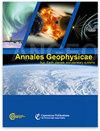径向行星际磁场(IMF)下的日侧磁层顶重联和通量转移事件:BepiColombo飞越地球观测
IF 1.9
4区 地球科学
Q3 ASTRONOMY & ASTROPHYSICS
引用次数: 1
摘要
摘要本研究分析了比皮可伦坡号近地飞行期间日侧磁层顶附近的通量传递事件(FTE)型通量绳和磁重联现象。磁鞘具有较高的等离子体β(~ 8),行星际磁场(IMF)具有显著的径向分量。在磁层顶周围确定了六条通量绳。通量绳的运动和最大磁切变模型表明,重联x线可能由于IMF径向分量的增加而在磁赤道附近扫过比皮可伦坡。通量含量最高的通量绳具有明显的聚结特征,即两个较小的通量绳合并,这支持了理论预测,即通量绳的通量含量可以通过聚结而增加。两种fte型助焊剂通过在两种助焊剂之间的接触点上进行二次重连接而合并。BepiColombo测量表明有一个大的归一化引导场和与磁层顶测量相当的重联率(~ 0.1)。本文章由计算机程序翻译,如有差异,请以英文原文为准。
Dayside magnetopause reconnection and flux transfer events under radial interplanetary magnetic field (IMF): BepiColombo Earth-flyby observations
Abstract. This study analyzes the flux transfer event (FTE)-type flux ropes and magnetic reconnection around the dayside magnetopause during BepiColombo's
Earth flyby. The magnetosheath has a high plasma β (∼ 8), and the interplanetary magnetic field (IMF) has a significant radial component. Six flux ropes are identified around the magnetopause. The motion of flux ropes together with the maximum magnetic shear model suggests that the reconnection X-line possibly swipes BepiColombo near the magnetic equator due to an increase in the radial component of the IMF. The flux rope
with the highest flux content contains a clear coalescence signature, i.e., two smaller flux ropes merge, supporting theoretical predictions that the flux contents of flux ropes can grow through coalescence. The coalescence of the two FTE-type flux ropes takes place through secondary reconnection
at the point of contact between the two flux ropes. The BepiColombo measurements indicate a large normalized guide field and a reconnection rate
comparable to that measured at the magnetopause (∼ 0.1).
求助全文
通过发布文献求助,成功后即可免费获取论文全文。
去求助
来源期刊

Annales Geophysicae
地学-地球科学综合
CiteScore
4.30
自引率
0.00%
发文量
42
审稿时长
2 months
期刊介绍:
Annales Geophysicae (ANGEO) is a not-for-profit international multi- and inter-disciplinary scientific open-access journal in the field of solar–terrestrial and planetary sciences. ANGEO publishes original articles and short communications (letters) on research of the Sun–Earth system, including the science of space weather, solar–terrestrial plasma physics, the Earth''s ionosphere and atmosphere, the magnetosphere, and the study of planets and planetary systems, the interaction between the different spheres of a planet, and the interaction across the planetary system. Topics range from space weathering, planetary magnetic field, and planetary interior and surface dynamics to the formation and evolution of planetary systems.
 求助内容:
求助内容: 应助结果提醒方式:
应助结果提醒方式:


